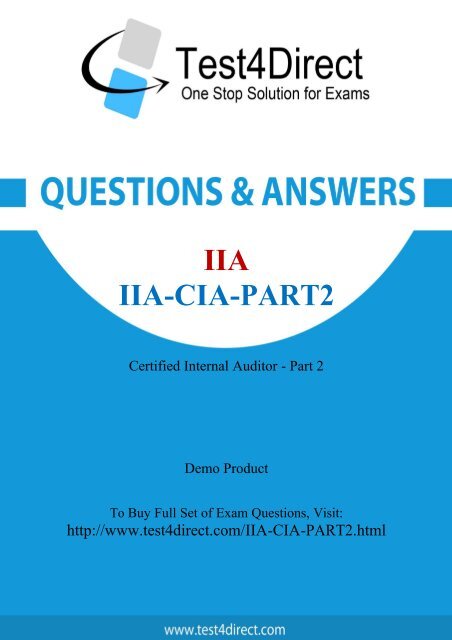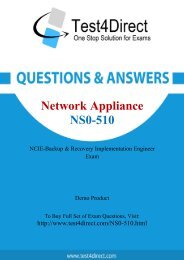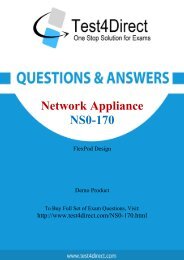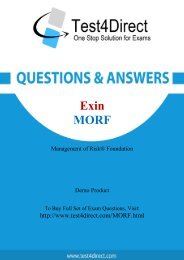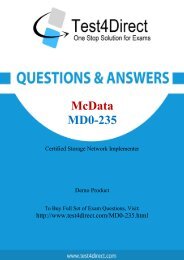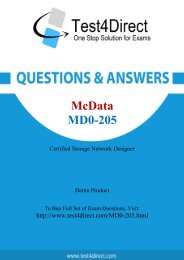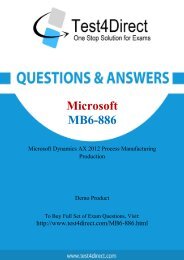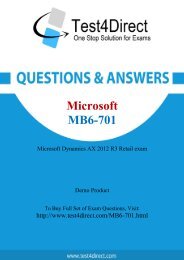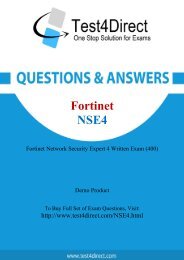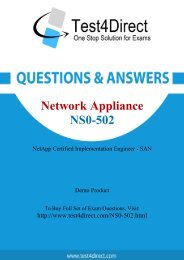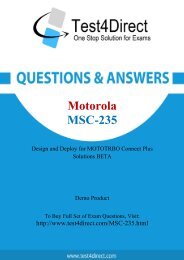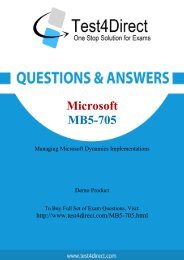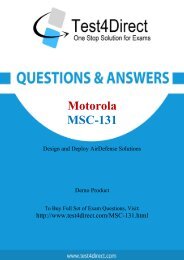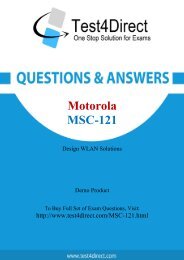IIA-CIA-Part2-demo
You also want an ePaper? Increase the reach of your titles
YUMPU automatically turns print PDFs into web optimized ePapers that Google loves.
<strong>IIA</strong><br />
<strong>IIA</strong>-<strong>CIA</strong>-PART2<br />
Certified Internal Auditor - Part 2<br />
Demo Product<br />
To Buy Full Set of Exam Questions, Visit:<br />
http://www.test4direct.com/<strong>IIA</strong>-<strong>CIA</strong>-PART2.html
Question: 1<br />
An auditor, assigned to review a complex computer system that had undergone a few system<br />
changes, obtained the prior flowchart used. Which of the following would be the most efficient way<br />
to document the changes?<br />
A. Create a new flowchart reflecting the system changes.<br />
B. Prepare a detailed narrative instead of a flowchart to describe the updated system.<br />
C. Add a detailed narrative to the prior flowchart to describe the changes to the system.<br />
D. Make the necessary adjustments on a copy of the prior flowchart and save as a new version.<br />
Question: 2<br />
When interrogating an individual who is suspected of fraud, it is appropriate to<br />
Question: 3<br />
Question: 4<br />
Answer: D<br />
A. Tell the individual that any information disclosed in the interrogation will not be disclosed outside<br />
of the company.<br />
B. Start the interview with questions to which the interviewer already knows the answer.<br />
C. Discontinue questioning once the individual has confessed to the fraud.<br />
D. Prepare a list of questions prior to the interrogation and strictly adhere to the list.<br />
Answer: B<br />
Which of the following is typically not a reason for committing financial statement fraud?<br />
A. To dispel negative market perception.<br />
B. To disguise a duplicate payment to a vendor.<br />
C. To obtain more favorable terms on financing.<br />
D. To receive performance related bonuses.<br />
Answer: B<br />
A company regularly invests excess short-term cash in trading securities. A reliable test of the<br />
valuation of those securities would be a<br />
A. Recalculation of investment carrying value using the equity method.<br />
B. Comparison of cost data with current market quotations.<br />
C. Confirmation of securities held by the broker.<br />
D. Calculation of premium or discount amortization.
Answer: B<br />
Question: 5<br />
Which of the following sampling plans should an internal auditor use to estimate the number of units<br />
in a certain class of inventory without counting each item?<br />
A. Attributes sampling.<br />
B. Discovery sampling.<br />
C. Variables sampling.<br />
D. Stop or go sampling.<br />
Question: 6<br />
Which of the following is an example of sampling risk?<br />
A. Overlooking material errors.<br />
B. Failing to analyze results properly.<br />
C. Checking invoices that are not representative of the population.<br />
D. Using audit procedures that are not appropriate for the given audit objective.<br />
Question: 7<br />
Which of the following would constitute a violation of the <strong>IIA</strong> Code of Ethics?<br />
Question: 8<br />
Answer: C<br />
Answer: C<br />
A. An internal auditor, who has recently joined the organization, has accepted an assignment to audit<br />
the electronics manufacturing division. The auditor previously served as senior auditor for the<br />
external audit of that division and has audited many electronics companies during the past two<br />
years.<br />
B. An internal auditor has accepted an assignment to audit the warehousing function six months<br />
from now. The auditor has no expertise in that area but has signed up for courses in warehousing<br />
that will be completed before the assignment begins.<br />
C. An internal auditor has no ambitions for promotion and has not engaged in training or other<br />
professional development activities during the last three years. The auditor's performance<br />
assessments indicate consistent quality of work.<br />
D. An internal auditor discovered an internal financial fraud during the year, and the financial<br />
statements were adjusted to properly reflect the loss associated with the fraud. The auditor<br />
discussed the fraud with the external auditor during the external auditor's review of the working<br />
papers detailing the incident.<br />
Answer: C<br />
A staff auditor, nearly finished with an audit engagement, discovers that the director of marketing
has a gambling habit. The gambling issue is not directly related to the existing engagement and there<br />
is pressure to complete the current engagement. The auditor notes the problem and forwards the<br />
information to the chief audit executive but performs no further followup. The auditor's actions<br />
would<br />
I. Be in violation of the <strong>IIA</strong> Code of Ethics for withholding meaningful information.<br />
II. Be in violation of the Standards because the auditor did not properly follow up on a red flag that<br />
might indicate the existence of fraud.<br />
III. Not be in violation of either the <strong>IIA</strong> Code of Ethics or Standards.<br />
A. I only.<br />
B. II only.<br />
C. III only.<br />
D. I and II only.<br />
Question: 9<br />
A code of ethics within the internal auditing profession is necessary in order to<br />
Question: 10<br />
Answer: C<br />
A. Reduce the likelihood that members of the profession will be sued for substandard work.<br />
B. Ensure that all members of the profession perform at approximately the same level of<br />
competence.<br />
C. Provide guidance to internal auditors in their service to others.<br />
D. Require members of the profession to exhibit loyalty in all matters pertaining to the affairs of their<br />
organization.<br />
Answer: C<br />
An investment portfolio manager has the authority to use financial derivatives to hedge transactions<br />
but is not supposed to take speculative positions. However, the manager launches a scheme which<br />
includes<br />
(1) taking a position larger than required by the hedge;<br />
(2) putting the speculative gains in a suspense account; and<br />
(3) transferring the funds to a nonexistent broker and from there to a personal account. Which of the<br />
following audit procedures would be least effective in detecting this fraud?<br />
A. Select a sample of individual trades and examine to determine whether the trades violate the<br />
authorization limit for the manager.<br />
B. Select a sample of individual trades and determine the exact matching of the hedge. Schedule and<br />
investigate all differences.<br />
C. Select a sample of all debits to the suspense account and examine their disposition.<br />
D. Select a sample of fund transfers to brokers and determine if the brokers are on the authorized list<br />
for company transactions.<br />
Answer: A
THANKS FOR TRYING THE DEMO OF OUR PRODUCT<br />
Visit Our Site to Purchase the Full Set of Actual <strong>IIA</strong>-<strong>CIA</strong>-PART2 Exam Questions With<br />
Answers.<br />
http://www.test4direct.com/<strong>IIA</strong>-<strong>CIA</strong>-PART2.html<br />
We Also Provide Practice Exam Software That Simulates Real Exam Environment And Has<br />
Many Self-Assessment Features. Download Free Product Demo From:<br />
http://www.test4direct.com/<strong>IIA</strong>-<strong>CIA</strong>-PART2.html<br />
Money Back Guarantee<br />
Check Out Our Customer Testimonials


